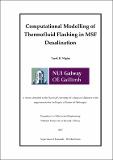| dc.description.abstract | Phase change inside a desalination flashing chamber arises from the surface evaporation with self-boiling of liquid brine flow due to a reduction of pressure. Flashing flow is the key to desalination of the feed water in every flashing chamber in multi-stage flash (MSF) desalination systems. The flashing process in the evaporation zone of a flashing chamber is investigated. A new classification of the flashing process as ideal, infinite and finite is proposed.
A computational field model for the flashing process in the evaporation zone inside a flashing chamber is developed around a two-phase volume of fluid (VOF) formulation. Two different phase-change mechanisms are allowed for, based on the saturation temperature and on the vapour pressure, respectively, that enable the model to compute the phase change regions, also the level and the shape of the free surface. The commercial computational fluid dynamics (CFD) code Fluent is used. The model is validated using data for an existing flashing chamber by solving for steady, two-dimensional, multiphase flow inside a flashing chamber without a baffle.
The model is then applied to investigate the effects of variations in the inlet brine flow rate and inlet brine temperature, for both finite and infinite flashing process classifications. Thermo-fluid behaviour and flow details are predicted, and performance results are presented in terms of flow patterns and distributions of gauge pressure, temperature, vapour volume fraction and mass transfer inside the flashing chamber. The predictions are analysed to estimate MSF design factors such as the non-equilibrium temperature difference and flashing efficiency. It is found that the chamber evaporation zone behaves differently for finite and infinite flashing processes. As has been observed experimentally, the flashing performance and vapour production are improved when the brine flow rate and its temperature are increased. | en_IE |


